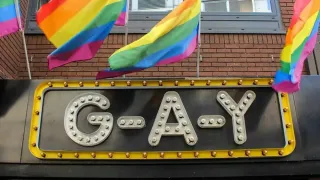April 19, 2015
Jacob Lawrence's Rhapsody in Blues
Kilian Melloy READ TIME: 4 MIN.
A master storyteller with a fine-tuned social conscience who used his gifts and a powerful artistic voice to become a leading chronicler of the African-American experience, Jacob Lawrence was a superb draftsman and visual thinker in an impressive range of mediums. Fifty-six of his paintings, drawings, rare color etchings and prints dating from 1943-98 are currently on view in "Promised Land: The Art of Jacob Lawrence," a new exhibition that emphasizes his figural strengths, narrative skills and a bold distinctive style characterized by a meld of Cubism and early 20th-century Social Realism.
The show, which sketches the evolution of his six-decade career, is a jewel in the crown for the Cantor Arts Center; it now boasts the largest permanent museum collection of the artist's work in the country. While that's welcome news, "Promised Land" seemed to promise more. It's somehow smaller than expected - it occupies one mid-sized upstairs gallery at the museum - and though the artist is known as a terrific colorist, many but by no means all of the show's works are muted in terms of their palette, if not in the intensity of their emotional thrust. Lawrence offers a passionate perspective of the flourishing black culture of post-war Harlem, and of the contributions of African-American builders who shaped the country's cities at the beginning of the 20th century, a subject strongly represented here.
The painful, violent struggle against slavery is brought to rousing pointed life in "The Legend of John Brown" (1978), a series of 22 silkscreen panels with austere modern imagery that's a controlled collision of the abstract and the figurative. The prints illustrate the true saga of the fanatical white abolitionist who believed he was a holy warrior anointed by God, the 1859 attack he led on Harper's Ferry, and his own bitter demise at the end of a hangman's noose. Although accompanied by brief captions that summarize the action in each episode, the pictures tell the story.
The fight for civil rights in the 1960s, and the barbarity it unleashed, resulted in some of Lawrence's most visceral social protest works. "Ordeal of Alice" (1963) is a nightmarish visual screed filled with outrage at racial violence and compassion for its innocent victims during attempts to integrate the schools. The tempera painting renders a terrifying, hellish scene in which a confused, traumatized little black girl toting her schoolbooks is jeered and set upon by grotesque demons. Her white Sunday-school pinafore is stained with blood where arrows of hatred have pierced it, a hooded blue gargoyle cloaked in black stands nearby, and a howling apparition the color of dried blood hovers on the upper right. Lawrence believed that irrational hatred, especially when directed at children, turned men into beasts.
While growing up in Harlem, a locale that put him at the epicenter of the Harlem Renaissance, Lawrence was surrounded by artists, writers and intellectuals, not to mention the streets inhabited by all manner of characters on sidewalks and stoops. The community made its flavorful way into works such as "At Times it is Hard to Get a Table in the Pool Room" (1943), a rhapsody in blues enveloping a neighborhood hangout. It's a study in improbable abstract geometries and skewed perspective. One can peer through the doorway and spy hustlers in indigo pants and peach T-shirts caressing their cues inside the joint as a policeman patrols the entrance.
Lawrence, a Southern transplant, didn't fit the standard art-world mold, but he surged to prominence in the 1940s after producing "Migration of the Negro" (1941), a major series reunited for a show that opened earlier this month at MoMA in New York. It was one of several narrative-painting sequences, a format at which he excelled, that would make his reputation. In 1989, Lawrence completed "The First Book of Moses, Called Genesis: King James Version" (1989-90), a large-format illustrated book project that tells the Biblical story of Creation. An Artist's Proof edition is displayed in a glass vitrine adjacent to eight chapter-like silkscreen passages from The Book of Genesis that were printed separately; their complex tonal qualities were achieved by utilizing as many as 21 screens for each print. They portray an animated, histrionic preacher at the pulpit in front of a rapt congregation, raising the rafters, throwing his body and soul into a fire-and-brimstone sermon, perhaps similar to one delivered by the consummate showman Adam Clayton Powell, Sr., whom Lawrence witnessed at the Harlem Baptist church in his youth. The rich colors of the preacher's robes change as the story progresses, and through high church windows one can see birds, rising ocean waves or starlit skies over the hills beyond. The artist's favorite motif, the toolbox, an emblem of building, growth and human labor, appears in every print, sometimes resting on a windowsill, on the floor near a pew or floating on air.
Through August 3






